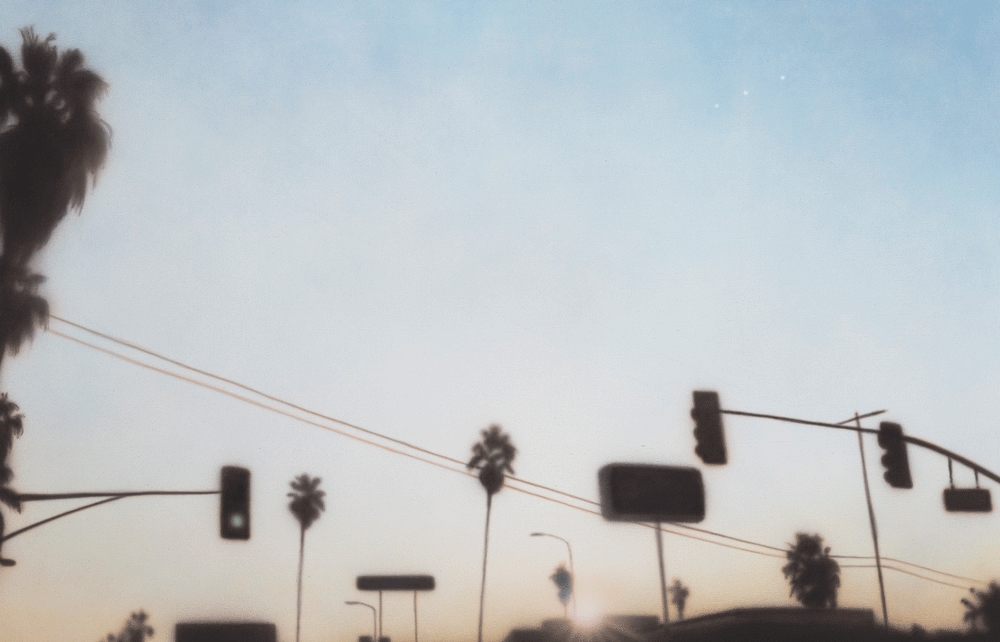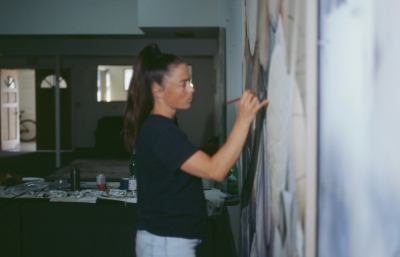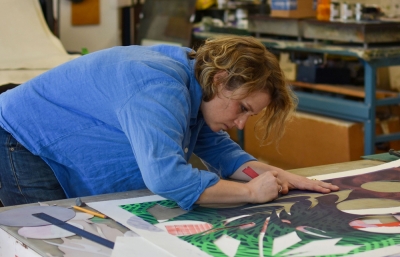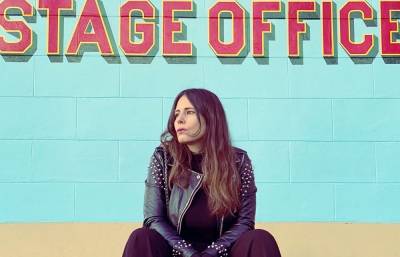Aryo Toh Djojo
A Close Encounter
Interview by Evan Pricco // Portrait by Max Knight
It feels quite apt that in the middle of a global pandemic, the US government would more or less admit the existence of UFOs. There was no Hollywood scripted announcement, no looming Independence Day threat. It was rather nonchalant, a passing press release. Nothing epic, nothing revelatory, a banal weather report.
Aryo Toh Djojo paints UFOs, but not in the way you might imagine. He paints a subtle haze of the world, other-worldly even. Many of his works feature a UFO hovering above, but they mostly capture a sense of wonder and a blurred sense of reality. We recognize his objects and his landscapes as California, but the film of memory and hallucinatory glaze make his paintings almost abstract. That is why speaking with him now, amidst the acknowledgement of UFOs, seems so perfectly timed. Where the US government exposed this information during the chaos of the times, Djojo’s works calmly hypnotize. His method of airbrushing and shading colors that mimic sunrise and sunset do not expose danger but rather a sublime dimension. It’s as if he has painted a magical mist over the California terrain through a legacy of open roads and alien encounters. Something brand new is emerging from the studio of Aryo Toh Djojo.

Evan Pricco: I guess I have to ask this at the start, but what is your favorite UFO movie, and of course, why?
Aryo Toh Djojo: Oh man, I don’t know. There’s so many good ones. Close Encounters of the Third Kind, 2001: A Space Odyssey, The Day the Earth Stood Still from 1951. If you want to talk about a real UFO movie though, I think, probably Unacknowledged by Dr. Steven M. Greer. It’s more of a documentary, but I think it’s one of the best at giving you insight of what might be happening in the world in terms of UFOs. I’d definitely recommend watching with an open mind.
What’s really interesting is that as soon as I saw your works, which are some of my favorite paintings right now, I could sense some sort of skate history, or that you were influenced by skating. I think there is something about being very observant that comes from skating. Do you think I'm wrong, is there something here?
Yeah, totally! I started skateboarding in 1996. I still skate, but now I’ve traded most of that energy and focus into painting. But skateboarding definitely played a huge role in my art practice.
As a skater, you’re automatically trained to be creative and observant on and off the board. We just look at the world differently. The everyday objects, like a set of stairs, a handrail or a ledge, we see those as things to jump off of, grind on, slide and or destroy. When you’re not skating, that mentality doesn’t turn off, so you end up applying it to whatever you’re doing. I think that’s why a lot of skaters end up becoming artists.
In terms of skateboarding influencing my work, I mean, I grew up in the capital and birthplace of skateboarding. I think that’s why most of the work is set in Los Angeles. I also think it’s that Cali vibe from skateboarding that kind of crept into the paintings.

Do you think this observant quality about skating has led you to be more attentive and open-minded about UFOs? Really, what I'm getting at is that there is a freedom in your work that really intrigues me and I want to get to the bottom of it.
I was thinking about this the other day. What’s kind of weird is that I feel like there have been signs that I should be making this work, and there is a purpose that I haven’t really pinpointed yet. My first board was an Alien Workshop, and the first time I saw a UFO was during my high school days while I was out skating with some friends. I started making this work right after I tried DMT. So I don’t know if it's a coincidence that now I’m thinking about them more and painting them in my work. But maybe “they” have been planning this for me all along [laughs]!
I do think that the freedom I’ve inherited through skateboarding is subconsciously being projected into my work and into my art practice. I think the only time I truly feel free is when I’m painting, skating or meditating. It all intertwines, so it’s eventually going to show up.
What was your childhood like in relation to art? Were your parents interested, or what is it that got you into art?
There’s this Indonesian tradition that my family told me: it's when the first born can start to crawl, the family would set the child down in front of a set of objects. Whatever the first object they grabbed would more or less define what they would be when they grew up. When my family told me this they said that the object I grabbed was a pencil and believed I was going to grow up to become an artist! I’ve always loved to draw ever since I was a kid and my family was always very supportive.

What did illustration and design at school help you with? I know you went to ArtCenter in Pasadena, so I’d like to connect the dots between school and now.
The first year of art school is mostly the fundamentals, like how to draw the figure, understand visual perspectives, and learn color theory and the principles of design. At the time, I hated some of those classes because I felt that most of it was geared towards traditional figurative painting. I also thought I wasn't very good at it. And halfway through art school, I started to feel like illustration and figurative painting was kind of boring.
One day, a friend of mine turned me on to abstract paintings, so I tried that out. As I got more involved, I noticed it gave me the same feeling I got when I was skateboarding. So I used what I learned during my first year of art school and applied it to abstract paintings instead. Fast forward to right before the pandemic hit when I picked up an airbrush and decided to try and paint a landscape with the tool for fun. The irony of it all is that I got really good at it and now I’m doing what I hated doing in art school. Ha ha. It’s a good thing I remembered some of those teachings, though, because I’m having fun with it now, and it got me here.
I think design has always been important for me in my art practice. I was taught that learning the fundamentals of design is important in understanding and creating anything. Once you’ve figured it out, you can bend, shape and break the rules to make something interesting.
Your work has a very Los Angeles feel, which is something that has come through in a lot of conversations I’ve had with artists recently, this idea of conveying a place like LA that is original and unique. You have that, as if you have taken the torch of Ruscha and Baldessari and turned LA upside down in your own way.
Ruscha and Baldessari are definitely the two artists I’ve been influenced by growing up. They’re the coolest dudes in the game in terms of artists making work in LA and about LA. I just love how their works are smart, funny and sometimes dumb, but in a good way. Some of the other artists who influenced me are Richard Prince, Gerhard Richter and Vija Clemins. I recently got turned on to Uta Barth by my cousin. He told me that my work looks like her photographs, and I also found out she’s an artist working in LA.
What’s weird about the works I’m making right now is that, in the beginning, I wasn’t intentionally trying to make work about LA. It just sort of started to seep out of me as I’ve been making them. I think, aesthetically, the airbrush has a big role in that it has a lot of ties with LA culture. But again, for me, it wasn’t intentional.

I read that you started with the airbrush just as the pandemic started. What is it about this tool that works for you?
I think it's the immediacy. I’m kind of impatient when I’m working. With the airbrush, you can cover a lot of surface really quickly and the dry time is pretty fast because the coats are painted thinly. I also like the challenge of using the tool. It's pretty unforgiving if you mess up on certain areas. Therefore, I have to be fully focused, not just in what I paint, but how I’m painting. In a way, it’s sort of like skateboarding and meditating.
I also like the sort of reference it has to some of the earliest cave paintings around the world. By putting dirt pigments in their mouths and then blowing out towards a wall while using their hands as a stencil, it was like making the first self portraits!
There is something about the way you use airbrush techniques that really creates a sense of mystery on the canvas, that sort of hazy clarity that makes you feel like there is something lurking in the mist. Would you say your work is cinematic? I wonder if that interests you.
Yeah, it definitely has a cinematic feel that also wasn’t intentional in the beginning. When I first started using the airbrush, I wanted to challenge myself to try and figure out how to use the tool in a sort of traditional manner in painting, and that’s the reason I don’t mask anything off or use stencils. By doing that, I realized it gave that cinematic vibe to the paintings. Also, since LA is one of the capitals of the entertainment world, maybe growing up here has something to do with it. I think a big part of how we relate to UFOs comes from all the sci-fi movies about them. So I’m also interested in how it relates to our culture.

Right now, what does LA mean to you?
Home. Always has been and always will be.
The reason I ask about LA so much in relation to your work is that there is this sort of "place that is constantly unfolding" quality to LA that you are able to turn into this metaphysical aesthetic. As if you see the moments in between. As you are sitting down to start building works this year, what is it you are thinking about?
I’m definitely interested in trying to capture those moments, and not just LA, but in general. I don't know how to explain it or if this will make sense, but I think we will never be present in that “in between moment” of reality where we can physically see time shifting. Time is constant and fluid. We can’t really pinpoint the beginning or end of time unless we’re conscious and fully aware of the present. But I don't know if that’s even possible because the in-between is the beginning and the end. Therefore, all you have is the present moment constantly unfolding. If anything, I think taking psychedelics or practicing meditation can maybe get you there. I guess what I’m trying to say is that in the unfolding present moment, that “in between” moment, that’s where the magic is. And all I’m trying to do is paint the shit out of it…

I think two of my favorite of your works are Breaking Rubbers and A wisp of cotton candy framing a paper cut. Your use of colors in both is just stunning. I know you don't use stencils, and the airbrush is a tool you work with, but can you talk about your approach to color? How are you able to capture that delicious, indescribable California layered sky?
To be honest, I think it’s because I’m not that great at color mixing!. But yeah, the colors never turn out the way they appear on my reference photos. I think that’s why the paintings look like they’re these weird moments in time that we don’t really recognize or are never really aware of in California. The paintings are never like morning, noon, or night. They end up looking a little more specific. Like these approximately random times of 5:22am,1:58pm, 4:19pm, 9:37pm or 2:53am [laughs]... And those are the times when UFOs usually show up. It’s always random. I like that idea and that I don't have full control of how the paintings turn out. The beauty lies in the mystery of the paintings and the mystery of how they’re made.
I look at your work and I see timelessness. There isn't a designated era or decade, and that is such a rare treat. As we tumble into a third year of time flipped upside down on itself, what does the concept of time mean to you right now? And does urgency mean anything to you?
I don't know. It’s all temporary. Time is temporary. And I think it’s really all in perspective. You can sit down and think about how things are fucked up right now or you can live life and try to observe and enjoy the present moment as it continues to unfold. Of course, it’s easier said than done but that’s just the reality of life happening before our eyes. If you try to control or understand it, you’ll miss the magic that is happening. Sure, there are things that need to change sooner than later. But, in the end, it will. Change is constant, patience is key.
All I’m trying to say is just enjoy the moment and look up once in a while. If you’re lucky, maybe you’ll catch yourself smiling at a UFO.
Aryo Toh Djojo will open a solo show at Sow & Tailor in Los Angeles in April, 2022.






